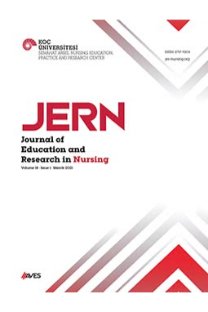Konjenital Osteopetrozis ve Hemşirelik Bakımı: Olgu Sunumu
Congenital Osteopetrosis and Nursing Care: A Case Study
___
- 1. Stark Z, Savarirayan R. Osteopetrosis. Orphanet J Rare Dis. 2009;4(5):1- 12. doi: 10.1186/1750-1172-4-5.
- 2. Diniz G, Kayserilioğlu E, Ortaç R, Aktaş S, Hızarcıoğlu M. Osteopetrozis: Olgu sunumu ve yeni gelişmeler. Türkiye Ekopatoloji Dergisi. 2004;10(3-4):137-40. Available from: http://web.deu.edu.tr/tepd/ pdf/10_34/137-140.pdf
- 3. Kumar KJ, Bandaru K, Prashanth SN, Mamatha S. Malignant infantile osteopetrosis. Indian J Hum Genet. 2013;19(1):90-2. Available from: https://www.ncbi.nlm.nih.gov/pmc/articles/PMC3722638/
- 4. Sobacchi C, Schulz A, Coxon FP, Villa A, Helfrich MH. Osteopetrosis: Genetics, treatment and new insights into osteoclast function. Nat Rev Endocrinol. 2013;9:522-36. doi: 10.1038/nrendo.2013.137.
- 5. Chate SV, Jaybhaye AP, Somshekharan R, Rathod TN. Aqueductal stenosis with optic atrophy in case of malignant osteopetrosis. J Nat Sci Biol Med. 2011;2(2):222-4. doi: 10.4103/0976-9668.92315.
- 6. Ajmal M, Mir A, Wahid S, Khor CC, Foo JN, Siddiqi S, et al. Identification and in silico characterization of a novel p.P208PfsX1 mutation in VATPase a3 subunit associated with autosomal recessive osteopetrosis in a Pakistani family. BMC Med Genet. 2017;18(148):1-9. doi: 10.1186/ s12881-017-0506-4.
- 7. Jain M, Mittal P, Shukla A, Kumar A. Osteopetrosis in twin infants mimicking leukemia. Rev Bras Hematol Hemoter. 2017;39(4):372-4. doi: 10.1016/j.bjhh.2017.06.002.
- 8. Bodur İ, Oğuz MM, Yılmaz G, Karacan CD, Zorlu P. Malign osteopetrozisli bir olgu. Türkiye Çocuk Hast Derg. 2014;1:35-8. Available from: https://dergipark.org.tr/tr/download/article-file/686075
- 9. Carpenito-Moyet LJ. Handbook of Nursing Diagnosis [Hemşirelik Tanıları El Kitabi]. Erdemir F, translator. İstanbul: Nobel Tıp Kitabevleri Ltd. Şti.; 2012.
- 10. Herdman TH, Kamitsuru S. NANDA International Nursing Diagnoses Definitions and Classification 2015-17. 10th ed. Oxford: WILEY Blackwell; 2014.
- 11. Akdoğan T, Yıldırım Z. Sağlıklı yenidoğanlarda ağrının değerlendirilmesi, emzik verme ve kucağa alma yönteminin etkisinin incelenmesi. Perinatoloji Dergisi. 1999;7(2):107-107. Available from: http://www. perinataldergi.com/Archive/Article/19990072013
- 12. Bulechek GM, Butcher HK, Dochterman JM, Wagner C. Nursing Interventions Classification (NIC) [Hemşirelik Girişimleri Sınıflaması (NIC)]. Erdemir F, Kav S, Akman Yılmaz A, translator. İstanbul: Nobel Tıp Kitabevleri / in collaboration with Elsevier; 2017.
- 13. Asadi-Noghabi F, Tavassoli-Farahi M, Yousefi H, Sadeghi T. Neonate pain management: What do nurses really know?. Global Journal of Health Science. 2014;6(5):284-93. doi: 10.5539/gjhs.v6n5p284.
- 14. Moorhead S, Johnson M, Maas ML, Swanson E. Nursing Outcomes Classification (NOC): Measurement of Health Outcomes. Elsevier Health Sciences; 2014.
- 15. Yalçın S, Arpa Y, Cengiz A, Doğan S. Hemşirelerin hastaların taburculuk eğitim gereksinimlerine yönelik görüşleri ile hastaların eğitim gereksinimlerine yönelik görüşlerinin karşılaştırılması. HEAD. 2015;12(3):204-9. doi: 10.5222/HEAD.2015.204.
- 16. Uslu S, Bülbül A, Bolat F, Baş EK, Nuhoğlu A. Annelere verilen yenidoğan sarılığı ve emzirme eğitimi ile erken yenidoğan poliklinik takibinin sarılık nedeniyle hastaneye yatış üzerine etkisi. Nobel Medicus. 2012;8(2):16-21. Available from: http://www.nobelmedicus.com/ Content/1/23/16-21.pdf
- 17. Aydın Acar Ç, Demet D. Hemşirelik eğitim sürecinde genetik. Ayrıntı Dergisi. 2017;55:11-5. Available from: http://www.dergiayrinti.com/ index.php/ayr/article/view/949/1705
- 18. Bhati P, Goyal PC. A rare case of osteopetrozis with unusual feature as microcephaly. J Clin Diagn Res. 2017;11(8):SJ01-2. doi: 10.7860/ JCDR/2017/27256.10406.
- ISSN: 2618-5741
- Yayın Aralığı: Yılda 4 Sayı
- Başlangıç: 2004
- Yayıncı: Koç Üniversitesi HYO Semahat Arsel Hemşirelik Eğitim ve Araştırma Merkezi (SANERC)
Multipl Sklerozlu Bir Olguda Neuman Sistemler Modeli’nin Uygulanması
Esin SEVGİ DOĞAN, ÖZDEN DEDELİ ÇAYDAM
Selmin KÖSE, Azime TÜRKÖZ ARAR, GÜLAY YILDIRIM
Hemşirelerin Çocuk Sevme Düzeyleri ve Terapötik Oyunu Kullanma Durumları
Deniz YİĞİT, EMEL SEZİCİ, AYFER AÇIKGÖZ
Dünyada ve Türkiye’de Okul Hemşireliğinin Gelişimi
MAKBULE TOKUR KESGİN, Songül ÇAĞLAR
Şiddete Maruz Kalan Kadınlara Yönelik Güçlendirme Programı ve Hemşirelik
Selvinaz ALBAYRAK, Lale Ayşegül BÜYÜKGÖNENÇ
Hemşirelerin Hasta Mahremiyetini Koruma ve Sürdürme Durumları ile Etkileyen Faktörler
GÜL GÜNEŞ AKTAN, İSMET EŞER, Elem KOCAÇAL GÜLER
Kronik Obstrüktif Akciğer Hastalığında Olgu Analizi
Konjenital Osteopetrozis ve Hemşirelik Bakımı: Olgu Sunumu
HALİL İBRAHİM TAŞDEMİR, EMİNE EFE
Cerrahi Alan İnfeksiyonlarını Azaltmada Antimikrobiyal Medikal Tekstil Ürünlerinin Etkisi
